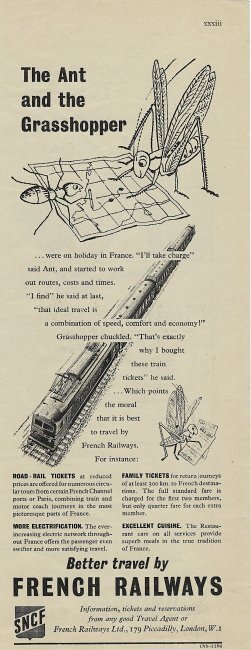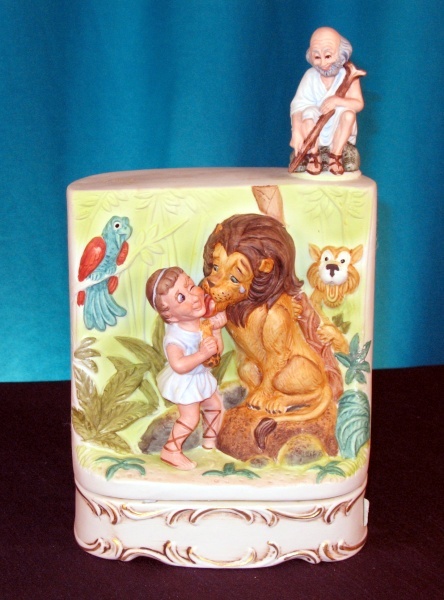Advertising
So far I have found a number of advertising items relating to movies and TV. I also have found three different postcards from one fable restaurant in San Francisco, the Drake-Wiltshire. I then came across a highly unusual set of advertisements sent to doctors for a drug that treats pinworm infections. Finally, I have found a number of individual advertising items. Most recently I have included a spectacular set of pain reliever advertisements from the French R. Gabutti in the 1950s. So you have many choices:
- Antiminth Oral Suspension
- Advertisements for the Film "Three Fables of Love"
- Other Movie and TV Ads
- Business Cards
- Drake-Wiltshire Postcards
- Gabutti French Pain Reliever Advertisements
- Gobey Laxative Syrup
- Gibbs Dental Care from "L'Illustration"
- Gustave Guérin MM Pamphlet
- L'Illustration advertisements by Benjamin Rabier
- Kingfisher Institute Cocktail Party
- Merrill Lynch
- Nestle Advertising Cards
- Wood-Milne Frictographic Pamphlets
- Rising Sun Stove Polish
- Sauba Frictographic Hidden-Picture Slips
- Individual Advertising Pieces
-
Alcoa advertisement: “If you remember, the moral of all these fables was the same.”1956 Alcoa advertisement: “If you remember, the moral of all these fables was the same.” 8.5” x 11.5”. Unknown source. The message in all five “fables” is “You can’t open an Alcoa Pilferpoof Closure secretly.” Eight different liquor bottles are displayed to help make the point. The fables themselves are, I would say, intentionally ridiculous.
-
“Fables for the Very Rich.”1966 “Fables for the Very Rich.” Advertisement for Francis I. duPont & Co, NY. The New Yorker, April 16, 1966. 4.6” x 5” on page 149, 7.75” x 11.25”. Source unknown. This advertisement promotes tax-free municipal bonds, highlighted for their tax-exempt interest and high returns. The fable has a somewhat addled llama write himself a letter. “What does it say?” “I don’t know. I won’t get it until tomorrow.” Moral: the familiar isn’t always the known.” Apparently the ambitious reader should make herself or himself more familiar with municipal bonds. I find no others in a possible series on the web.
-
Alcoa Aluminum advertisement “The Goose that made an Asp of itself: A Pilferproof Fable.”1956? Alcoa Aluminum advertisement “The Goose that made an Asp of itself: A Pilferproof Fable.” 2.7” x 10.9”. No date. Unknown source. This advertisement for Alcoa Pilferproof Closures features a fable about a goose attempting in vain to secretly open a bottle of Glenmore whiskey. The "Pilferproof Fable" illustrates the security of Alcoa's closures, which prevent tampering. The moral emphasizes that only a "silly goose" would try to secretly open a Pilferproof Closure, the slotted band holding the cap securely on a bottle. A quick search finds two other such Alcoa ads on the web.
-
Mercury advertisement “Here’s The Simple, Sensible Idea That Makes MERCURY Different! Get Yourself A Flying License!”1941? Mercury advertisement “Here’s The Simple, Sensible Idea That Makes MERCURY Different! Get Yourself A Flying License!” 8.35” x 11.5”. Unknown source. There is a simple illustration of the tortoise and hare in the upper left. “Fleet-footed, nimble and alert, the hare can beat the turtle every time – no matter what the fable says!” The advertisement, found several times elsewhere on the web, seems to spread to the very end of the page left and right. Google recognized this ad immediately and correctly deciphered it as comparing the car to a fast airplane.
-
“The Fable of the Hen Who Laid Easter Eggs Every Day.” advertisement1950? New Yorker Advertisement: “The Fable of the Hen Who Laid Easter Eggs Every Day.” New York: W & J Sloane. No date. Source Unknown. Ophelia laid a colored egg on Easter, and her master was pleased. So she began laying an egg of a different color every day. Then one day a muddy brown egg came. So she turned to two-toned eggs, spotted eggs, striped eggs. The master got more and more disappointed as time went on. Finally he asked “Could you lay a perfectly plain egg?” She had completely forgotten how. When you visit the Sloane store, you will be impressed by the original ideas. But you will be impressed even more “by the restraint with which this originality is used.” I find no echoes of this advertisement on the web.
-
Anderson Consulting Ad, The Tortoise and the Hare1990 Xerox of an advertisement in the Wall Street Journal using TH: “Today they would both be losers.” Anderson Consulting (Arthur Andersen & Co.). Page C9. Unknown source. “There aren’t many tortoises left.” But, we are told, we should not model our business on the hare either, especially when it comes to information technology. “These days it takes both to be a winner. And that, we believe, is the new moral of this old story.” The image looks suspiciously like one in I believe the image is taken from an inexpensive classroom kit that happens to be in our collection. Now to find it!
-
"The Fisherman who got a Bight" advertisement1957 New Yorker advertisement for Edward Petry & Co: “The Fisherman who got a Bight.” Full page. August 31, 1957. Unknown source. This advertisement, marked “A Fable,” goes a long way around to tell a story of someone who did not advertise well. Its best phrases are “not very bright about Bights” and “the Bight was a beaut.” Edward Petry will help you to use radio to advertise well!
-
Carbel advertisement1926 “Vendre” full-page advertisement for Carbel. “Montrez-moi patte blanche … ou je n’ouvrirai point!” Sept., ’26. 8.3” x 10.5”. Unknown source. Carbel was apparently a major manufacturer of carbon and ribbon. “The most important specialized house of Europe.” Here it plays off of the La Fontaine fable where the young goat wisely demands of the wolf caller outside his door that he not only offer his mother’s voice but that he also show “white paw.” Notice the Carbel man made up of various round typewriter ribbons; his chest is in fact a typewriter.
-
Doxa, Le Heron Ad1950? Full-page advertisement for Doxa timepieces. “Les Fables de La Fontaine: Le Heron.” 8.75” x 12.2”. Unknown source. This full-page advertisement may echo the treatment of “Le Heron” in Doxa’s 1950 booklet. Here the message is “Do not be like the heron. Do not hesitate to buy a Doxa!” The web shows a similarly formatted Doxa advertisement using TH.
-
Fables from the Golden Age for Modern Dry Cleanersby PPG Chemicals
-
Advertising Stamp Äsop1885 Advertising Stamp "Äsop, Langenscheidt’s Abriss der Geschichte der Antiken Literatur von Dr. Erwin Rex," Serie 9 (12 Bilder), Bild 11. €5 from Bartko-Reher, Feb., '25. "Erwin Rex" is a pen-name for Paul Langenscheidt, son of a publisher and eventual founder of his own publishing house. This "stamp" with a full account of Aesop on its verso seems to be an advertisement for the volume "Langenscheidt's Abriss." Or is it part of an album that is somehow part of "Langenscheidt's Abriss"? My, the ephemeral left-behinds of civilization!
-
French Railways (SNCF) advertisement based on GA from a British magazine1950? French Railways (SNCF) advertisement based on GA from a British magazine. 4¼" x 11¼". Gift of Susan Carlson, Dec., '24. As Susie said in giving me this extraordinary piece of advertising, it is a "crossover" of my interests in railways and fables. The text here has little reference to the story of GA. The ant takes charge of the pair's holiday together. "Ideal travel is a combination of speed, comfort, and economy!" The grasshopper answers that those are his very thoughts and that is why he has already bought the tickets. The best clue I can find for dating this unusual piece is that trains in France are in the process of "more electrification." Good going, SNCF!











